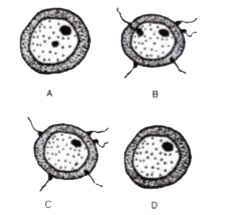a) Explain the phenomenon of double fertilization.
b) Describe the post-zygotic events leading to implantation and placenta formation in humans. Mention any two functions of placenta.
Step-by-Step Solution
1. Definition: Double fertilization is a unique reproductive process that occurs in flowering plants (angiosperms).
2. Male Gametophyte: In flowering plants, the male gametophyte, represented by the pollen grain, produces two male gametes.
3. Fertilization Events:
- Syngamy: One male gamete fuses with the female gamete (egg) to form a diploid zygote. This process is called syngamy. The zygote will undergo multiple divisions to develop into the embryo.
- Triple Fusion: The second male gamete fuses with the two polar nuclei present in the central cell of the embryo sac. This fusion is known as triple fusion, resulting in a triploid cell called the primary endosperm nucleus (PEN).
4. Endosperm Development: The primary endosperm nucleus will divide to form the triploid endosperm, which serves as a nutrient source for the developing embryo.
5. Conclusion: The term "double fertilization" refers to these two distinct fertilization events: one leading to the formation of the embryo and the other leading to the formation of the endosperm.
---
Part B: Post-Zygotic Events Leading to Implantation and Placenta Formation in Humans
1. Fertilization: In humans, fertilization occurs in the fallopian tube when the male gamete (sperm) fuses with the female gamete (ovum), resulting in the formation of a diploid zygote.
2. Cleavage: The zygote undergoes a series of mitotic divisions known as cleavage, transforming it into a multicellular structure called the embryo.
3. Movement to Uterus: As the embryo develops, it moves from the fallopian tube towards the uterus.
4. Implantation: Upon reaching the uterus at the 8 to 16 cell stage, the embryo embeds itself into the endometrial lining of the uterus, a process known as implantation.
5. Formation of Placenta: After implantation, the embryo develops finger-like projections called chorionic villi, which interdigitate with the maternal tissue, forming the placenta.
6. Functions of the Placenta:
- Nutrient and Gas Exchange: The placenta facilitates the exchange of oxygen and nutrients from the mother to the fetus and the removal of waste products from the fetus to the mother.
- Endocrine Role: The placenta produces hormones such as human chorionic gonadotropin (hCG), relaxin, and human placental lactogen, which are essential for maintaining pregnancy and supporting fetal growth.
---
2. Male Gametophyte: In flowering plants, the male gametophyte, represented by the pollen grain, produces two male gametes.
- Syngamy: One male gamete fuses with the female gamete (egg) to form a diploid zygote. This process is called syngamy. The zygote will undergo multiple divisions to develop into the embryo.
- Triple Fusion: The second male gamete fuses with the two polar nuclei present in the central cell of the embryo sac. This fusion is known as triple fusion, resulting in a triploid cell called the primary endosperm nucleus (PEN).
- Nutrient and Gas Exchange: The placenta facilitates the exchange of oxygen and nutrients from the mother to the fetus and the removal of waste products from the fetus to the mother.
- Endocrine Role: The placenta produces hormones such as human chorionic gonadotropin (hCG), relaxin, and human placental lactogen, which are essential for maintaining pregnancy and supporting fetal growth.
Topper's Solved these Questions
- BOOK - XII BOARD PREVIOUS YEAR PAPER ENGLISHCHAPTER - XII BOARDSEXERCISE - Delhi Board : Set II Section-A1videos
XII BOARDS
- BOOK - XII BOARD PREVIOUS YEAR PAPER ENGLISHCHAPTER - XII BOARDSEXERCISE - DELHI BOARD : SET-III (SECTION -A)2videos
XII BOARDS
- BOOK - XII BOARD PREVIOUS YEAR PAPER ENGLISHCHAPTER - XII BOARDSEXERCISE - OUTSIDE DELHI: SET III (SECTION A)2videos
XII BOARDS
- BOOK - XII BOARD PREVIOUS YEAR PAPER ENGLISHCHAPTER - SAMPLE PAPER 2019EXERCISE - Section E Part B3videos
SAMPLE PAPER 2019
Similar Questions
Mention any four functions of placenta.
View SolutionState any three functions of placenta in human female.
View SolutionWhat is double fertilisation? Describe the process giving its significance. Add a note on post-fertilisation changes leading to the formation of seed.
View SolutionExplain accelerated europhication. Mention any two consequences of this phenomenon
View SolutionExplain any two functions of cerebrospinal fluid in humans.
View SolutionBriefly explain explain the events of fertilization and implantation in an adult human female .
View SolutionBriefly describe the structre of nucleus and mention its any two function.
View SolutionMention the site of fertilization of a human ovum. List the events that follow in sequence until the implantation of the blastocyst.
View SolutionGiven below are diagrams showing the different stages in the process of fertilisation of an egg in the human female reproductive tract.
Study the diagrams and answer the questions

(i) Arrange the letters given below each diagram in a logical sequence to show the correct order in the process of fertilisation.
(ii) Where does fertilisation normally take place? What is 'Implantation' that follows fertilisation ?
(iii) Mention the chromosome number of the egg and zygote in humans.
(iv) Explain the term 'Gestation'. How long does Gestation last in humans ?
(v) Draw a neat, labelled diagram of a mature human sperm.View SolutionThe diagram given below is that of a developing human foetus. Study the diagram and then answer the questions that follow :

(i) Label the parts numbered 1 to 3 in the diagram.
(ii) Mention any two functions of the part labelled 2 in the diagram.
(iii) Explain the significance of the part numbered 3 in the diagram.
(iv) Define the term 'Gestation'. What is the normal gestational period of the developing human embryo?
(v) Mention the sex chromosomes in a male and female embryo.View Solution

